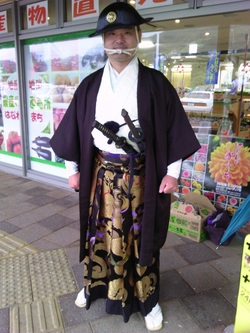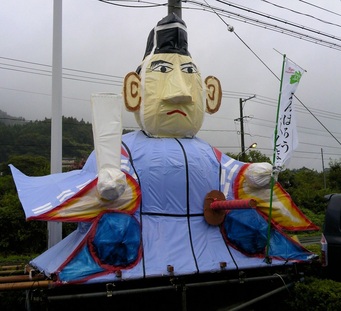When you go on a cycle tour, your shoes are the weakest link. I realised this while making my way around Hokkaido three years ago, where the weather was, to say the least, changeable. If a t-shirt or a pair of shorts get wet, you can hang them up and they’ll be dry by the next morning, but if it’s a pair of shoes, you’ll be stuck with damp feet for the next couple of days, and quite possibly a chronic case of athlete’s foot into the bargain. As a consequence, a lot of touring cyclists in Japan wear sandals or even flip-flops, but this summer I compromised on one pair of ordinary shoes and one pair of fake Crocs (500 yen at Shimamura – which is a kind of Japanese version of Peacocks – as opposed to 1500 for the genuine article). Because they’re made of plastic, Crocs don’t soak up any water, and because they’re so light, they also come in handy when you’re trying to keep your baggage to an absolute minimum.
There was no doubt about it when I woke up on the morning of Sunday 21st: the Crocs would be my footwear for the day, and the proper shoes would stay safely tucked away in my panniers. It didn’t exactly chuck it down from dawn till dusk, but then again, there wasn’t exactly anything that you could call a dry spell either, so rather than sailing along and admiring the scenery, today was very much a case of putting my hood up, getting my head down and grinding out the kilometres.
By midday I had made it into Fukushima Prefecture – still a fair distance from the nuclear evacuation zone, but as Tokidoki Tokyo pointed out, almost completely devoid of tourists – and stopped for lunch at a michi-no-eki (道の駅 / literally ‘road station’). Whereas a motorway services in the UK will be massively overpriced, and present the motorist with a depressingly generic selection of junk food and stodgy snacks, at a michi-no-eki, you can choose from cheap and delicious cafeteria food (noodles, tempura etc.), cheap and delicious off-the-back-of-a-van food (octopus balls, rice dumplings etc.) or a large selection local specialities (gift-wrapped cakes and sweets, seasonal fruit and veg etc.). As it happened, I had been given a leftover bento box at a festival the previous evening, which I ate in the cafeteria while gazing out at the rain, and before getting back on the bike, I decided to ask this guy what he was up to.

‘I’m dressed as Teranishi Jujiroh,’ he said, and proceeded to tell me about Teranishi’s life and achievements. Fortunately, he also gave me a leaflet about Teranishi, so what follows is a mixture of what I can remember from our conversation, and what I’ve managed to translate from the leaflet.
Teranishi was born in Hiroshima in 1749, and grew up in poverty. By his mid-twenties he had been employed by the shogun, and in 1792 was sent to Hanawa Town to act as governor. Such governors were posted to the far reaches of the country not just to enforce shogun rule, but also to act as lookouts, sending word back to Edo (now Tokyo) if any kind of trouble was in the offing. Because of his background, Teranishi was unusually sympathetic to the suffering of his subjects, and rather than being transferred to another outpost after three or four years – a rule that was devised as a way of preventing corruption – he remained in Hanawa for more than two decades, and while he was there, created what you could argue was a template for modern Japanese society – for societies all over the world, even.
When Teranishi arrived in Hanawa, its people were just getting over a famine, and in order to aid the town’s recovery, he exempted farmers from land taxes and lent them money (the interest generated was used to help orphaned children); he created farming infrastructure, including irrigation and dykes; he turned the town into a centre for the horse trade, opening a regular market and giving subsidies to help people buy their own horses; and he built a public warehouse to store food in case of future famines. Teranishi even built Japan’s first public park, and based on Confucian principles, drew up a kind of constitution for the town. Known as ‘The Eight Articles Of Teranishi’ (寺西八ヵ条), here is a rough translation:
1 – Heaven is tremendous – Heaven is visible from the Earth, it rewards good and punishes evil
2 – Land is important – Arable land must be managed
3 – Parents are important – One must devote oneself to one’s parents
4 – Children must be treated with compassion and tolerance – Children are precious and must be brought up with equality
5 – Couples must get along with and support each other for their whole lives
6 – Siblings must get along – Siblings must be friendly and help each other
7 – One must be industrious in one’s vocation – One must work hard and live frugally
8 – Everyone must love their hometown – People must be amiable and patient with each other
Not only that, but families were central to the town’s new philosophy, so that under Teranishi’s rule, money was lent to cover the expense of getting married, financial incentives were offered to encourage people to have children, along with financial assistance once the children were born, a record was kept of pregnancies and births, the health of mothers and their children was protected by law, mothers and children from outside the district were encouraged to come and live there, and nannies were employed to help with child rearing.
What all this progressive thinking engendered was a successful frontier town, which went from being poor and neglected to being an important stop on the road to and from what is now Tohoku. Teranishi was so popular and so successful that he was even allowed to hand over control of the area to his sons – another act that was normally frowned upon by his superiors – and the people thanked him by building the Teranishi Shrine in his honour.
‘Instead of being selfish or covetous,’ said Teranishi’s modern-day representative, ‘the people of Hanawa helped each other out and shared what they had. He’s become a symbol of the town – that’s him over there as well.’ He pointed to a cloth and wire sculpture on the other side of the car park.

The costumed man – whose real name I forgot to write down – went off on all kinds of tangents as he was telling me about Teranishi (for example, how in ancient times, people walked on the left to enable them to defend themselves more effectively with their swords, hence Japan being one of the few countries that still drives on that side of the road) and in the end, I realised that unless I drew the conversation to a close myself, he would quite happily talk all day. I had initially assumed that he was with a group of fundraisers for 24-Hour Television (Japan’s version of Children In Need, for which celebrities don’t necessarily donate their appearance fees to charity – or so onii-san had told me), but apparently not.
‘Tomorrow I have to go back to work,’ he said. ‘But I come here whenever I am free and tell people about Teranishi.’ The fundraisers had mysteriously dispersed while we were chatting, so I said goodbye and left him in front of the michi-no-eki, ready to buttonhole another unsuspecting tourist with an impromptu history lecture.
Having struggled on for another couple of hours I reached a place called Kitsuné-uchi in Higashi-mura (東村 / East Village). Kitsuné-uchi (きつねうち / Home of the Fox) is a complex of sports facilities, a junior high school, an onsen (温泉 / hot springs) and a campsite, whose receptionist told me that since I lived outside the town, he was obliged to charge me 1200 yen for the privilege of pitching my tent. After some concerted haggling, I managed to get the price down to 300, a fact that I later came to feel rather guilty about when I realised that 1200 yen (5 or 6 quid) is the going rate for a campsite pretty much everywhere in Tohoku.
I watched the closing stages of 24-Hour Television in the onsen relaxation room, before making another new friend as I was cleaning my teeth in the campsite toilets – it was raining so hard that even the frogs had come inside to seek shelter.
